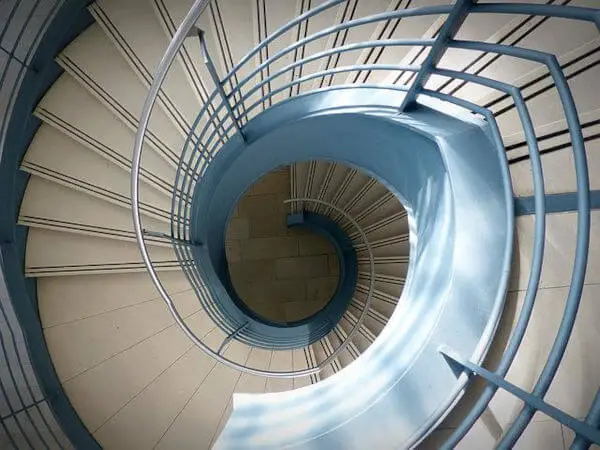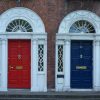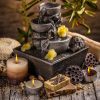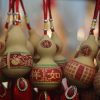
Staircases have their own energy, and they often give Feng Shui consultants a lot of trouble. Although not as popular in Asia, the staircase is an essential element of most homes in Europe and the United States.
Just like the main door is the key formation when examining a home, the staircase is the key to getting Qi from downstairs to upstairs. The entry to the second floor is by the stairs.
Staircases do more than just let us get from one floor to another. Stairways, when appropriately positioned, may assist the energy that resides in our home, known as chi, in moving up and down effortlessly and smoothly.
Conversely, inauspicious stairs throw off the chi’s harmony and balance and have an impact on several aspects of your life.
Therefore, the correct design and Feng Shui placement of stairs are essential components of a balanced and harmonious home design that attracts good fortune and prosperity.
Here are some basic feng shui principles for stairways.
Staircase at The Centre of the Home
Staircases in the middle of the house are negative for Feng Shui. The center of the house ought to be a stable area with little to no activity. Because staircases require a lot of Qi activity, having the staircase in the center of the house is considered inauspicious.
Consider your home’s center to be its heart. The continual “up/down energy” released by the stairs will eventually wear out this heart. Finally, the energy of those occupying or using the area will reflect this.
Staircases on the side of the house are preferred to those in the middle.
Spiral Staircase
The spiral staircase is becoming increasingly popular in recent homes. Some feng shui experts are totally against them, while others are more open-minded. Everyone agrees that they shouldn’t be in the middle of the house. The objection is not to the staircase itself, but to what it is constructed of and how narrow and confined it is.
If the spiral staircase is one of those really narrow corkscrew types, all metal and with exposed stairs, as you could see on a ship, this is not good. Qi, like any other individual, will have difficulty reaching the second floor. Additionally, it represents pressure and stress on the inhabitants.
Dual Staircases
Many big homes have two sets of stairs, one to the right and one to the left of a central entryway or hallway. If the structure is exceedingly huge, such as a big hotel, this is not regarded as a concern.
The difficulty with smaller buildings, such as houses, is that the Qi is not unified. It’s heading in two different directions. If the main entrance is enclosed by double stairs, this is not regarded as fortunate since the Qi leaves the residence too quickly.
Wrapping a long strand of (real or fake) ivy around the railing from the top to the lower step is a remedy for such circumstances. You may also place a plant at the top of the steps or in the center of the staircase where it curves.
Related reading: 11 Feng Shui Benefits That Will Transform Your Life (From Sleep to Success!)-Opens in new tab
Stairs Facing the Main Entrance
When a staircase is exactly opposite, aligned with, and facing the front entrance, it makes a difficult feng shui layout because it allows energy to flow fast and straight in and out of the front door, which might signify dwindling resources or wealth.
A staircase, in general, signifies ups and downs, which may be quite disruptive. A staircase close to the front entrance can have a big influence on the energy flow throughout the property.
The staircase is immediate across from the entryway, which is not an optimal placement. It may be a concern if the staircase is less than 10 feet from the front entrance or less than twice the height of the home’s tallest resident.
There are a few more things that may provide further difficulty. Watch out for entrances that are small, dark, and narrow, and for stairs that are tall and narrow. When these things happen, your entryway’s qi can feel squished and trapped.
If, on the other hand, the foyer or doorway is wide, spacious, and bright, or if you have a bright and functioning light fixture above the staircase or foyer, this arrangement is unlikely to be an issue. These settings allow the qi that enters your house to grow and flow more freely.
If you have a staircase that faces the main door, you might want to put some lucky plants on the sides to prevent the chi from flowing away from the main level.
Another cure is to put a rug down at the base of your staircase in order to slow the qi and ground this location. Consider using a circular area rug to smooth out the qi and promote circulation. You might also try installing a partition to prevent the view of the staircase right in front of the main door.
If your staircase ends at the front entrance, leave a bright light on at the door or in the foyer where the steps are located. Alternatively, a crystal might be hung between the staircase and the front entrance.
Bedroom Facing Stairs’ Beginning or End
It is best if the bedroom entrance is not immediately facing the top or bottom of the stairs. This layout makes the room feel like it’s flooding with energy, which could be bad.
Additionally, it may cause energy to leave the bedroom’s occupants, leading to issues with finances and health like low thyroid or depression that are linked to low energy.
Before entering a room or bedroom, there should always be a tiny open area (mini Bright Hall) where Qi may gather. The same holds true for any room that is directly across from a stairway.
🍀 Our “Feng Shui Master” app is your trusted companion, offering a useful guide to implementing Feng Shui principles. Try it now!
Stairs with Open Risers
Many homeowners have purposefully eliminated the handrail in certain modern home designs for an aesthetic effect. However, staircases with open risers lose flow and energy, enabling chi to flow directly through the staircase rather than up into the next level. This is particularly problematic for second-floor houses or apartments.
Furthermore, railings on staircases provide a sense of security when climbing and descending steps.
The solution to this sort of staircase is to enclose the gap between the risers. If enclosing the risers isn’t practical, use wallpaper or huge artwork representing vertical topics, such as trees, to help the chi energy go higher.
The Area Under the Staircase
Water, such as fountains, ponds, and aquariums, should not be placed beneath your stairway. It can be dangerous for kids.
Similarly, restrooms positioned there, particularly those in the center of the house, drain much more precious energy and harm all occupants. They also take wealth away.
Ideally, there should be a storage space beneath the steps. Having storage in the area underneath a stairway is better for feng shui than leaving it vacant. Or, you can install a home altar beneath your steps if there is enough space.
Related Reading: Common Things you Should NOT Keep at Home According to Feng Shui – Opens in new tab
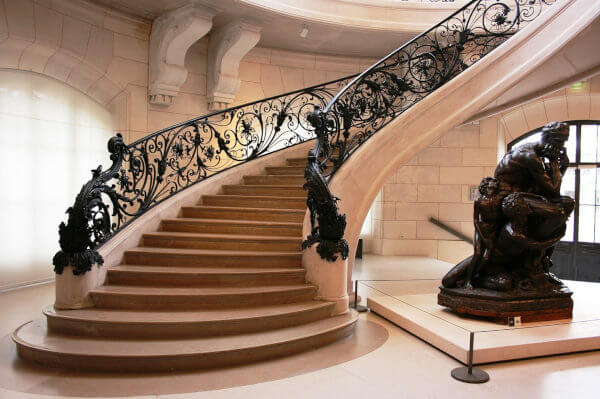
Further Feng Shui Tips for Stairs
Staircase coverings
Tile, carpet, or wood are all excellent coverings, yet wood is favored since it provides rising, expanding energy.
However, avoid using the color red. While red is considered a lucky color in China, it is not appropriate for your staircase.
Red is related to the fire element and may cause an uncomfortable, burning energy to rush up the stairs, searing everything in its path. The family may experience poor luck and misfortune as a result.
Avoid the Mirror at the Top of the Stairs
The placement of a mirror and console table at the top of a staircase or landing is a common design option. However, the flow of beneficial chi up the stairs is disrupted by a mirror at the top of the staircase. The mirror sends the chi energy back down the stairs, so the energy doesn’t move in the rooms on the upper floor.
Make Vertical Lines to Help Positive Energy Move Upstairs
You may entice chi energy up the stairs by including vertical lines in your paintings, art items, architectural elements, and other designs.
- Use artwork with vertically oriented subjects such as trees, towering buildings, or other things.
- Large, tall ceramics may be put towards the bottom, safely away from the steps, to help form vertical lines that will aid the chi energy as it rises up the stairway.
- Set up three ceramic vases of different sizes in a wall niche or along a landing.
- Tall plants, flower bouquets, or feather plumes can generate additional vertical height to enhance chi energy.
Install Adequate Lighting
Make sure the stairway is well-lit in order to direct chi energy to the upper level and boost visibility. Safety is another reason for a well-lit staircase, due to the potential for unintentional accidents, including falls from a height.
Putting uplighting along the landing is a great way to bring good chi up to the next floor. As the preferred source of overhead lighting in the entryway, a chandelier made of crystal can be employed. Chi energy will spread throughout the house and up the stairs thanks to the stones and light.
Take a look at some Feng Shui product ideas – Opens in new tab
Feng Shui Diploma Course
- Certified Course
- Accredited Course
COURSE INFORMATION
- 10 Modules
- Lifetime Access
- Study Group Access
Use “LIGHTWARRIORSLEGION466 ” code for 70% off.
Feng Shui Tips for Stairs When Building a New Home
Avoiding the creation of inauspicious staircases is far simpler than trying to find a solution. When you follow a few feng shui suggestions for stairs for a new house building, you can ensure that the chi energy in your home is preserved and enhanced.
Best Feng Shui Location for Stairs in the House
The optimal place for a staircase is not immediately across from the front entrance, but rather along an outside wall.
Allow Enough Space for Movement
You should make sure that the staircase is broad enough for at least two people to pass each other effortlessly. If the stairs are narrow, it makes individuals feel uncomfortable and insecure.
Select the Proper Material
When building stairs, you should use solid materials like wood, metal, or concrete. Soft materials should be avoided for safety reasons as well.
It’s preferable to have.
- Wooden staircases in a home’s south, east, and south-east
- Metal staircases in the North.
- Concrete staircases in the north-east, south-west, west, and north-west.
Staircase shape
Curved staircases are preferable. This design allows energy to flow up to the upper floor of the home, rather than rushing in. This way, it won’t mess up or disturb the energy field around it.
The number of steps
Many Chinese people thought that odd numbers of steps were for humans and even numbers were for spirits. Aside from this superstition or belief, it is a matter of rhythm that might alter your equilibrium. Accidental falls are more likely while walking up an even number of stairs.
In classic Feng Shui, there are two methods for calculating the number of step sets.
- First, sets may be counted by three steps. It is known as the Gold-Silver-Death cycle. According to Feng Shui house design advice, the final set of steps should be Gold or Silver.
- The second way counts as one set of steps, every four steps. It’s known as the Success-Prosperity-Failure-Decline cycle. It is favorable when the last staircase set of steps corresponds to the Success or Prosperity step.
End Words
This brings us to the end of this post since you now have a thorough understanding of feng shui stairs. Using these Feng Shui rules for the stairs will allow Chi energy to circulate throughout the property. It may create a sense of balance and harmony in your house and family.
Here are some of the most popular feng shui rules, organized by room, from our other articles.
- Feng Shui Rules and Tips for Your Front Door and its Surroundings
- Best Feng Shui Rules and Tips for the Living Room
- Basic Feng Shui Rules and Tips for Dining Room
- Basic Feng Shui Rules and Tips for Kitchen
- Basic Feng Shui Rules and Tips for the Bedroom
- How to Feng Shui Your Bathroom
- Basic Feng Shui Rules and Tips for Staircases and How to Apply them
- Simple Guide to Feng Shui Your Workspace
- Feng Shui Your Garden: Design Your Dream Garden with Feng Shui Principles
Online Courses about Feng Shui from Udemy (Aff.link)
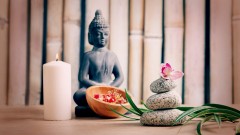
Stay in Touch
 Join our newsletter by using the forms on this website or click here!
Join our newsletter by using the forms on this website or click here! Follow us on Google News
Follow us on Google News Follow us on Facebook
Follow us on Facebook
Featured Image by David Mark from Pixabay

